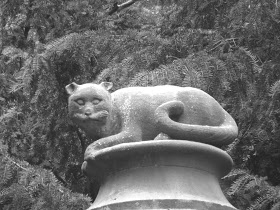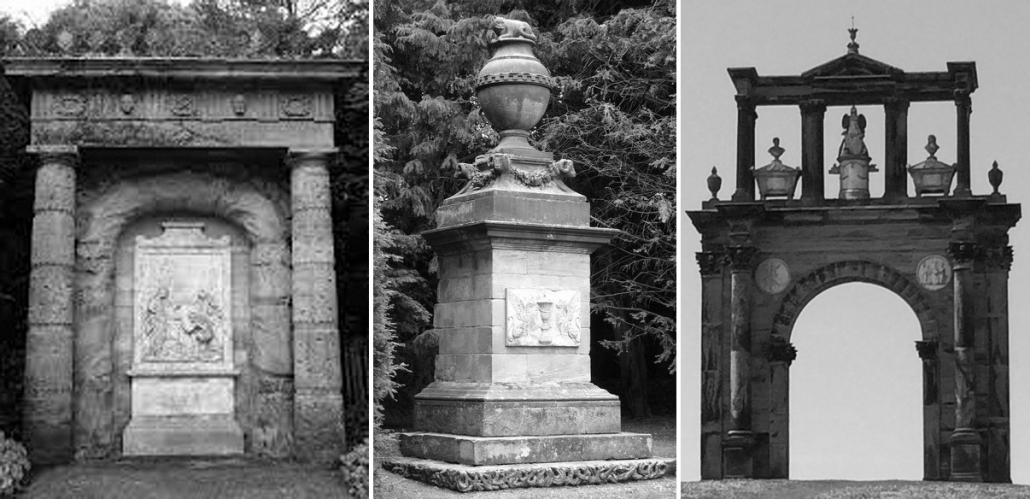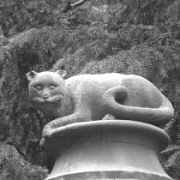MONTHLY BLOG 117, AN EIGHTEENTH-CENTURY FOLLY-BUILDER & CAT-LOVER
If citing, please kindly acknowledge copyright © Penelope J. Corfield (2020)

Public monuments to cats – as opposed to literary, artistic and musical celebrations1 – are rare to find, especially dating from the eighteenth century. So this majestic example deserves full appreciation. The lordly cat sits atop a giant Grecian vase, all forming the substantial Cat Monument.2 It was designed in 1749 and built c.1770 in the new weatherproof composite known as Coade Stone.3 Erected at Shugborough Park in Staffordshire, the Monument was commissioned by Thomas Anson (c.1695-1773). He was the felinophile, who owned the estate and had the wealth as well as the space to indulge his taste for architectural patronage in full.
Curiously enough, the identity of this publicly honoured cat remains uncertain. One strong possibility is that it commemorates Thomas Anton’s own favoured pet, named Khouli-Khan. This cat was the last of a line of Persian cats owned by the family. Hence, behind the luxuriant mustachios on the Monument’s lordly feline, the statue may show the round face and short muzzle that is characteristic of that particular breed.
Another possibility, however, is that the honoured cat was the adventurous moggy who circumnavigated the globe in the years 1740-44 with Admiral George Anson (1697-1762). He was the much admired younger brother of Thomas Anson. And the childless George Anson had bequeathed his great fortune, based upon Spanish treasure, to his older sibling. As a result, some of the monuments and memorabilia at Shugborough Park were devised as fraternal tributes to the circumnavigator. In that context, therefore, it is possible that the Cat Monument commemorates the circumnavigating cat.
Throughout this period (as in earlier and later eras), thousands of feline pest controllers travelled the high seas.4 They dined on the mice and rats which infested the wooden ships of the commercial fleet and the Royal Navy. (Keeping pets on board was banned by the British Navy only in 1975). Often these sailing cats were adopted by the crews as informal mascots. The feline companion (name unknown) of George Anson seems to have been a talisman of that ilk. Indeed, it is quite possible that the Cat Monument commemorates not one specific cat but human admiration for the species generically. The design is certainly eclectic. Around the Monument’s plinth are the carved heads of Corinthian goats, which were kept on the Shugborough Park estate c.1768. But the lofty cat is the king.
Accompanying the Monument, meanwhile, Anson commissioned an extraordinary array of follies and fancies.5 The Chinese House (1747) is one of the earliest examples of oriental design in Britain. A Gothic Ruin, complete with a gothic pigeon-house, followed in 1750. The Shepherd’s Monument was built in the later 1750s, taking the form of an ornamental arch around a pastoral bas-relief. (Two outer pillars and a classic pediment were added in 1763). A Doric Temple followed in c.1760. The massive Hadrian’s Arch was then erected in 1762, at a high point on the estate with extensive views. Built in a style borrowed from classical Athens, the design was adapted as a tribute to George Anson, who died in 1762, and George’s wife Elizabeth. A Tower of the Winds, based upon the Athens’ Horologium of Andronikos, was created in 1765, initially with a surrounding pool of water, which was lost in the course of flood damage on the estate in 1795. And in 1771 the Lanthorn of Demosthenes, based upon the design of an Athenian house dating from 4BCE, completed Anson’s career as an alfresco architectural patron. (He also remodelled the ancestral Shugborough Hall and amassed a collection of memorabilia).
Amongst this eclectic miscellany of edifices, the Cat Monument more than holds its own. It has a stately presence, framed by trees. It is not overawed by its Gothic, Oriental, Doric or Corinthian monumental companions, elsewhere in Shugborough Park. Whether it commemorates one adventurous globe-trotting feline, or one exotic Persian cat, or all cats generically, it makes its point finely.

|
Fig.2.1-3 Three Shugborough Park Monuments, Commissioned by Thomas Anson: |
Around the globe – and at home in Staffordshire – feline companionship is something to admire. A cat may look at an admiral or at a country landowner (and MP) or at a king. And humans look closely at these classic domestic companions too. At a time of global crisis, compounded of climatic, epidemiological, economic and political challenges, it is as well for humans to recollect their pan-global co-residence with all living beings. And, not least among them, those great triggers to the literary imagination in the form of the amiable, adventurous, wily, and famously enigmatic cats.6
ENDNOTES:
1 H. Loxton, Cats: 99 Lives – Cats in History, Legend and Literature (1999).
2 For the Cat Monument (designed 1749; erected c.1770) NGR: SJ9932022722, see https://www.nationaltrust.org.uk/shugborough-estate/features/parkland-buildings-monuments-and-follies
3 H. Van Lemmen, Coade Stone (Princes Risborough, 2006).
4 See V. Lewis, Ship’s Cats in War and Peace (2001); and listings in https://en.wikipedia.org/wiki/Ship%27s_cat/.
5 All monuments are listed and dated in https://www.nationaltrust.org.uk/shugborough-estate/features/parkland-buildings-monuments-and-follies
6 See P.J. Corfield, ‘“For I will Consider my Cat Jeoffry”: Cats and Literary Creativity in Eighteenth-Century Britain’, work-in-progress for publication 2021.
For further discussion, see Twitter
To read other discussion-points, please click here
To download Monthly Blog 117 please click here

